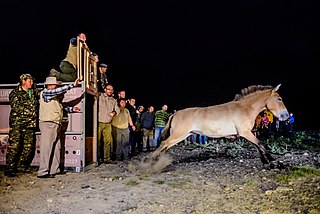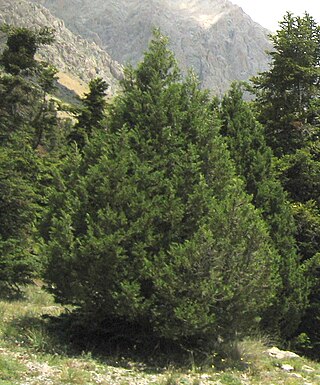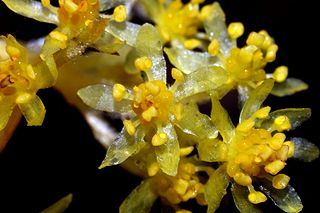
Millets are a highly varied group of small-seeded grasses, widely grown around the world as cereal crops or grains for fodder and human food. Most millets belong to the tribe Paniceae.

Sorghum or broomcorn is a genus of about 25 species of flowering plants in the grass family (Poaceae). Sorghum bicolor is grown as a cereal for human consumption and as animal fodder.

Pinus sylvestris, the Scots pine (UK), Scotch pine (US), Baltic pine, or European red pine is a species of tree in the pine family Pinaceae that is native to Eurasia. It can readily be identified by its combination of fairly short, blue-green leaves and orange-red bark.

Species reintroduction is the deliberate release of a species into the wild, from captivity or other areas where the organism is capable of survival. The goal of species reintroduction is to establish a healthy, genetically diverse, self-sustaining population to an area where it has been extirpated, or to augment an existing population. Species that may be eligible for reintroduction are typically threatened or endangered in the wild. However, reintroduction of a species can also be for pest control; for example, wolves being reintroduced to a wild area to curb an overpopulation of deer. Because reintroduction may involve returning native species to localities where they had been extirpated, some prefer the term "reestablishment".

Pearl millet is the most widely grown type of millet. It has been grown in Africa and the Indian subcontinent since prehistoric times. The center of diversity, and suggested area of domestication, for the crop is in the Sahel zone of West Africa. Recent archaeobotanical research has confirmed the presence of domesticated pearl millet on the Sahel zone of northern Mali between 2500 and 2000 BC. 2023 was the International Year of Millets, declared by the United Nations General Assembly in 2021.
Indel (insertion-deletion) is a molecular biology term for an insertion or deletion of bases in the genome of an organism. Indels ≥ 50 bases in length are classified as structural variants.

Juniperus excelsa, commonly called the Greek juniper, is a juniper found throughout the eastern Mediterranean, from northeastern Greece and southern Bulgaria across Turkey to Syria and Lebanon, Jordan, the Caucasus mountains, and southern coast of Crimea.

Juniperus foetidissima, with common names foetid juniper or stinking juniper, is a juniper tree species in the family Cupressaceae.

Sorghum bicolor, commonly called sorghum and also known as great millet, broomcorn, guinea corn, durra, imphee, jowar, or milo, is a species in the grass genus Sorghum cultivated for its grain. The grain is used for food for humans; the plant is used for animal feed and ethanol production. Sorghum originated in Africa, and is now cultivated widely in tropical and subtropical regions.

The southern birch mouse is a species of birch mouse in the family Sminthidae. It is native to southern Russia, Kazakhstan, and potentially northern Mongolia and China.

Widdringtonia wallichii, Clanwilliam cedar or Clanwilliam cypress, previously Widdringtonia cedarbergensis is a species of Widdringtonia native to South Africa, where it is endemic to the Cederberg Mountains northeast of Cape Town in Western Cape Province. Due to harsh weather conditions, like limited rainfall and frequent wildfires, growth is limited. Ring width almost correlates with rainfall due to such harsh environmental conditions It is threatened by habitat loss and protected in South Africa under the National Forest Act of 1998.

The striped laughingthrush is a species of bird in the family Leiothrichidae.

The Chinese mole shrew is one of four species of Asian mole shrew in the genus Anourosorex.

Sassafras randaiense is a species of deciduous tree in the family Lauraceae belonging to the genus Sassafras. It is a relict species endemic to Taiwan. It is threatened by habitat loss.

Mangifera indica, commonly known as mango, is an evergreen species of flowering plant in the family Anacardiaceae. It is a large fruit tree, capable of growing to a height of 30 metres. There are two distinct genetic populations in modern mangoes – the "Indian type" and the "Southeast Asian type".

Neglected and underutilised crops are domesticated plant species used for food, medicine, trading, or cultural practices within local communities but not widely commodified or studied as part of mainstream agriculture. Such crops may be in declining production. They are considered underutilised in scientific inquiry for their perceived potential to contribute to knowledge regarding nutrition, food security, genetic resistance, or sustainability. Other terms to describe such crops include minor, orphan, underused, local, traditional, alternative, minor, niche, or underdeveloped.

Ambrosina is a genus in the family Araceae that consists of only one species, Ambrosina bassii, and the only genus in the tribe Ambrosineae. This species is the smallest terrestrial aroid in the Mediterranean, growing only to 8 cm tall. It is usually found growing in woodlands on north faces of hillsides and in humus soil that is covering limestone. It is distributed in Sardinia, Corsica, Sicily, southern mainland Italy, Tunisia, and Algeria.

Hakea pulvinifera, also known as Lake Keepit Hakea, is a small, prickly shrub in the family Proteaceae, found only on one rocky hillside at Lake Keepit near Gunnedah in New South Wales, Australia. The species was first described in 1962, believed extinct in 1971 and rediscovered in 1988. The entire species may be of only one genetically unique individual. It is one of only two Hakea species that reproduce solely through basal shoots or 'suckering', reducing genetic variation.
The striped darter is a species of freshwater ray-finned fish, a darter from the subfamily Etheostomatinae, part of the family Percidae, which also contains the perches, ruffes and pikeperches. It is found in the lower Cumberland River drainage in Kentucky and Tennessee, in the upper Caney Fork system in central Tennessee; and in Rockcastle River and nearby streams in eastern Kentucky. It inhabits rocky pools of headwaters, creeks and small to medium river. This species can reach a length of 7.8 cm (3.1 in), though most only reach about 4.8 cm (1.9 in).
Sorghum purpureosericeum is a species of plant in the grass family, Poaceae, that occurs in central and eastern Africa, Yemen and India.
















